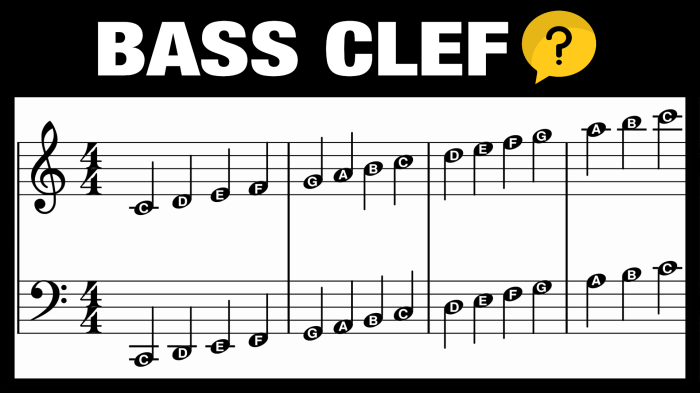E flat major triad bass clef – Beginning with the e flat major triad in the bass clef, this comprehensive guide delves into the intricacies of this fundamental musical element, exploring its structure, inversions, and practical applications in musical contexts. Prepare to embark on a journey of musical enlightenment as we uncover the secrets of this versatile triad.
The e flat major triad, a cornerstone of Western music, plays a pivotal role in shaping harmonies and enriching musical compositions. This guide will equip you with a thorough understanding of its construction, inversions, and its significance in various musical contexts, empowering you to incorporate it effectively into your own musical endeavors.
Key Signature and Scale

The key signature of E flat major consists of three flats: B flat, E flat, and A flat. In the bass clef, this means that the B, E, and A lines will have flat symbols next to them on the staff.
E flat Major Scale in Bass Clef
The E flat major scale in the bass clef is as follows:
- E flat
- F
- G
- A flat
- B flat
- C
- D
- E flat
Triad Construction

A triad is a three-note chord that forms the basis of Western harmony. It consists of a root note, a third above the root, and a fifth above the root. The E flat major triad is constructed with the following intervals:
Root Position
- Root: E flat (E♭)
- Major third: G (G♮)
- Perfect fifth: B flat (B♭)
Musical Notation
The following is a musical notation example of an E flat major triad in the bass clef:

Inversions

Inversions are variations of a chord where the notes are rearranged, changing the order of the intervals. This affects the sound and function of the chord.
The E flat major triad has three inversions, each with a distinct intervallic structure:
Bass Note and Intervallic Content
- Root Position:E♭ (root), G (major third), Bb (perfect fifth)
- First Inversion:G (root), Bb (major third), E♭ (perfect fifth)
- Second Inversion:Bb (root), E♭ (major third), G (perfect fifth)
As the bass note changes, the intervals between the notes also change, altering the harmonic sound of the chord.
Chord Progressions

The E♭ major triad can be used in various chord progressions, offering a rich and harmonious foundation for musical compositions.
Common Progressions
- E♭ major- B♭ major – F minor: This progression creates a sense of movement and resolution, with the F minor chord providing a contrasting and satisfying conclusion.
- E♭ major- A♭ major – D♭ major: This progression explores the relationship between the E♭ major triad and its parallel minor key, creating a sense of harmonic tension and release.
- E♭ major- F minor – B♭ major – E♭ major: This extended progression incorporates both the previous progressions, providing a more complex and satisfying harmonic journey.
Musical Notation Examples
- E♭ major- B♭ major – F minor:
E♭(bass)– B♭ (bass)– F (bass)
- E♭ major- A♭ major – D♭ major:
E♭(bass)– A♭ (bass)– D♭ (bass)
- E♭ major- F minor – B♭ major – E♭ major:
The E flat major triad in bass clef is a fundamental chord that sets the foundation for countless musical compositions. Its simple yet evocative sound has captivated musicians for centuries. Intriguingly, the hand sign for the fraternity Pi Kappa Phi pi kappa phi hand sign bears a striking resemblance to the fingering used to play this triad.
This connection between music and fraternity underscores the enduring power of both traditions.
E♭(bass)– F (bass)– B♭ (bass)– E♭ (bass)
Musical Context: E Flat Major Triad Bass Clef

The E-flat major triad in the bass clef is commonly used in a wide range of musical contexts, from classical to jazz and popular music.
In classical music, the E-flat major triad serves as a foundational harmonic structure in compositions by composers such as Mozart, Beethoven, and Schubert. It often provides stability and a sense of resolution within musical phrases and cadences.
Examples in Classical Music, E flat major triad bass clef
- Mozart’s “Piano Sonata No. 11 in A major, K. 331”: The E-flat major triad appears in the opening measures, establishing the tonal center of the piece.
- Beethoven’s “Symphony No. 5 in C minor, Op. 67”: The E-flat major triad is prominently featured in the second movement, providing a contrasting and uplifting section within the overall somber tone of the symphony.
Voice Leading

In voice leading, the E flat major triad in the bass clef adheres to specific principles to ensure smooth melodic flow and harmonic stability.
When moving from one triad inversion to another, the outer voices (root and fifth) should generally move in contrary motion, while the middle voice (third) may move in either direction.
Proper Voice Leading Techniques
| From | To | Root | Third | Fifth |
|---|---|---|---|---|
| Root Position | First Inversion | Down | Up | Down |
| First Inversion | Second Inversion | Down | Down | Up |
| Second Inversion | Root Position | Up | Up | Down |
These principles help create a sense of harmonic direction and avoid awkward voice crossings.
FAQ Explained
What is the structure of an e flat major triad?
An e flat major triad consists of the notes e flat, g, and b flat, stacked in thirds.
How many inversions does an e flat major triad have?
An e flat major triad has three inversions: first inversion (g in the bass), second inversion (b flat in the bass), and third inversion (e flat in the bass).
What is the role of the e flat major triad in musical contexts?
The e flat major triad is commonly used in chord progressions, providing stability and resolution. It also appears in various musical genres, from classical to jazz and pop.